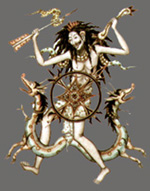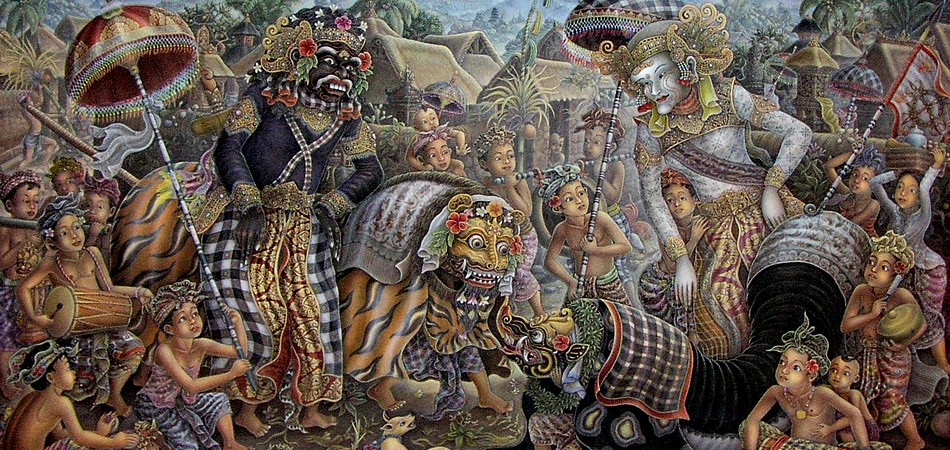Introduction to Balinese Art
Tumbal, I Dewa Sobrat, 1938, Museum Puri Lukisan

Balinese Art is of Hindu-Javanese origin that grew out from the artisans of the Majapahit Kingdom with their expansion to Bali in late 13th century. Since then, Ubud and its neighboring villages have been the center of Balinese Art. Ubud and Batuan are known for their paintings, Mas for their woodcarvings, Celuk for gold and silver smiths, and Batubulan for their stone carvings.
Prior to 1920s, Balinese traditional paintings were restricted to what is now known as the Kamasan or Wayang style. It is a visual narrative of Hindu-Javanese epics: the Ramayana and Mahabharata. These two-dimensional drawings are traditionally drawn on cloth or bark paper (Ulantaga paper) with natural dyes. The coloring is limited to available natural dyes: red, ochre, black, etc. In addition, the rendering of the figures and ornamentation must follow strictly prescribed rules, since they are mostly produced for religious articles and temple hangings. These paintings are produced collaboratively, and therefore mostly anonymous.
In the 1920s, with the arrival of many western artists, Bali became an artist enclave, similar to Tahiti for Paul Gaugain, for avant-garde artists such as Walter Spies (german), Rudolf Bonnet (dutch), Le Mayeur (belgian) to Arie Smith (dutch) and Donald Friend (australian).
in the recent years. In addition, Bali has attracted world famous anthropologists from Stutterheim (dutch) to Gregory Bateson and Margaret Mead (american). It was during their stay in Bali in mid 1930s, Bateson and Mead collected over 2000 paintings, predominantly from the village of Batuan.
Among the western artists, Spies and Bonnet are often credited for the modernization of the traditional Balinese paintings. They provided painting media and introduced western painting concepts, such as picture and color composition and human anatomy. More importantly. they acted as agents of change by encouraging individual freedom of expression.
The results were the explosion of individual expression that led to the birth of the neo-traditional Balinese paintings. The Ubud painters embraced it with the most courage and enthusiasm.

The modernization took the forms of: (1) shifting of the subject matter from the narration of religious epics to the depiction of daily life and drama; (2) changing the patron from the religious temples and royal houses to western tourists/collectors; (3) shifting the picture composition from a multiple to single focus. The latter is more evident in the works of Ubud artists.
Despite the adoption of modern western painting tradition by many Balinese and Indonesian painters, the neo-traditional Balinese painting tradition is still thriving and continued by decedents/students of the artists of the pre-war modernist era (1928-1942).
Aside from the Kamasan school of painting, there are now a wide range of different styles, mostly based on geographic location:
Ubud School. Most influenced by the Western use of perspective and proper human anatomy, and the most expressionist of all the Balinese schools, the Ubud school still retains many traditional features: including attention to detail and very stylized characters.
Pengosekan School. Heavily influenced by the great Balinese artist I Gusti Ketut Kobot, student of Tjokorda Oka Gambir, Prince of the royal house of Peliatan, the Pengosekan schools is characterized by depiction of Balinese mythology and folklore using soft pastel colors. Among the followers are I Gusti Made Baret, I Wayan Gedot and Dewa Putu Mokoh. In 1970s, a new style sprang up within the Pengosekan School that captured close-ups of nature: birds, insects, butterflies and plants.
Batuan School. Least affected by western influences, the Batuan school is characterized by the narrative expression of Balinese mythology and folk lore with pain staking attention to detail and leaving no empty spaces on the canvas. Early Batuan artists, documented by the American anthropologists: Margaret Mead and Gregory Bateson, depicted the darker, supernatural side of life in Bali, showing the Balinese people’s vulnerability to spirits and powers of nature. Later artists from Batuan, notably I Made Budi and I Wayan Bendi, have depicted the interplay between contemporary and traditional life in Bali, with paintings that show the reality of modern Bali: traditional village activities commingled with camera-toting tourists and surfers.
Sanur School. Painters from this village by the sea depict many aspects of sea life. In addition, some artists of Sanur, especially I Rundu, paint geometrical objects in the manner of Escher. Most early paintings were black and white, but later, colors were added at the suggestion of gallery owners, the Neuhaus brothers.
Young Artist School. The development of the Young Artist School is attributed to the Western painter and longtime resident of Bali, Arie Smit, who noticed children’s paintings in the village of Penestanan, on the outskirts of Ubud. With his encouragement these peasant artists started exploring the use of simple forms and vivid colors, without attention to detail or perspective.
Keliki School. From peasant artists in the villages of Keliki and Payangan, 10 miles north of Ubud, this school is very similar to the Batuan School in subject matters and style, but executed in miniature sizes: as small as 2 x 3 in to around 10 x 15 in. Typical subject matter are scenes of Balinese mythology and folk lores depicting the battle of good and evil on full and frightening backgrounds.
Exhibitions:
- “Ida Bagus Made – the Art of Devotion,” Puri Lukisan Museum, Bali (2008)
- “Pioneers of Balinese Painting – the Rudolf Bonnet Collection,” Puri Lukisan Museum, Bali (2008)
- “Crossing Boundaries – Bali: A Window to Twentieth Century Indonesian Art,” Asia Society Australasia Center (2002)
- “Peasant Painters from the Penestanan Ubud Bali – Paintings from the Collection of Datuk Lim Chong Keat”, National Art Gallery Kuala Lumpur (1983).
- “Hedendaagse Kunst van Bali,” Centraal Museum, Utrecht, Netherlands (1961)
- “De Kunst van Bali – verleden en heden,” Haags Gemeentemuseum, Netherlands (1961)
- “Indonesian Art – A Loan Exhibition from the Royal Indies Institute Amsterdam,” The Asia Society, New York (1948)
General References:
- Couteau, Jean, “Museum Puri Lukisan Catalog”, Ratna Wartha Foundation (1999)
- Dermawan, Agus, “Bali Bravo – A Lexicon of 200-years Balinese Traditional Painters,” Bali Bangkit (2006)
- Djelantik, Anak Agung, ” Balinese Paintings,” Oxford University Press (1990)
- Fischer, Joseph, “Problems and Realities of Modern Balinese Art,” in Modern Indonesian Art: Three Generations of Tradition and Change 1945-1990, Joseph Fischer, editor (1990)
- Geertz, Hildred, Images of Power: Balinese Paintings Made for Gregory Bateson and Margaret Mead, University of Hawaii Press (1994)
- Haks, F., Ubbens J., Vickers, A. , Haks, L. and Maris, G., “Pre-War Balinese Modernists,” Ars et Animatio (1999)
- Höhn, Klaus D., “The art of Bali: Reflections of faith : the history of painting in Batuan, 1834-1994,” Pictures Publishers Art Books (1997)
- Moerdowo, “Reflections on Balinese Traditional and Modern Arts,” Balai Pustaka (1983)
- Neka, Sutedja and Kam, Garrett, “The Development of Painting in Bali – Selections from the Neka Art Museum,” 2nd edition, Museum Neka Dharma Seni Foundation (2000)
- Rhodius, Hans and Darling, John, ” Walter Spies and Balinese Art,” Terra, Zutphen (1980)
- Ruddick, Abby, “Selected Paintings form the Collection of the Agung Rai Fine Art Gallery,” The Agung Rai Fine Art Gallery (1992)
- Taylor, Alison, “Living Traditions in Balinese Painting,” The Agung Rai Gallery of Fine Art (1991)
